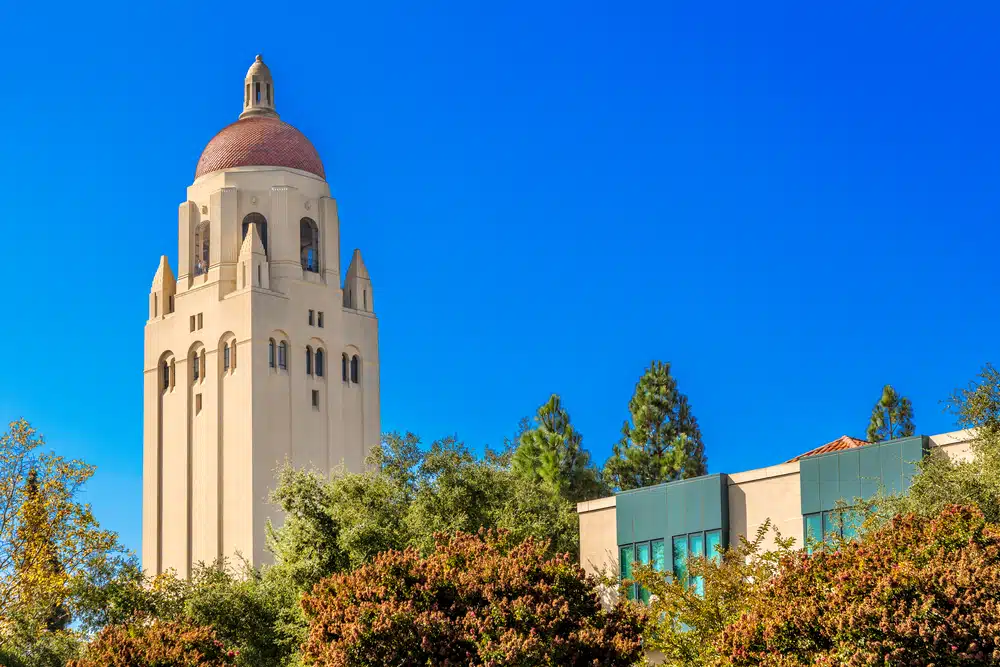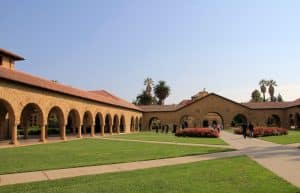Stanford Campus Size: A Comprehensive Guide for Aspiring College Students
What is the Stanford campus size?
What is the size of the Stanford campus? At 8,180 acres, Stanford University boasts one of the largest college campuses in the United States. Its size is not only impressive but also serves a purpose, as it houses a wide range of academic and research facilities, state-of-the-art sports complexes, and beautiful residential areas.
Located approximately 37 miles southeast of San Francisco and 20 miles northwest of San Jose, Stanford is nestled between the cities of Palo Alto and Menlo Park. With its prime location in the heart of Silicon Valley, it’s no surprise that Stanford has a strong connection to the tech industry, providing countless opportunities for students interested in innovation and entrepreneurship.
The Stanford campus is a harmonious blend of nature, architecture, and open spaces, making it not only functional but also aesthetically pleasing. The design of the campus promotes a sense of community and collaboration while providing students with access to a lot of resources. Here are some key aspects of the Stanford campus:
Architectural Style
Stanford’s campus features a variety of architectural styles, from Romanesque and Spanish Colonial Revival to modern designs. The university’s signature sandstone buildings with red-tiled roofs offer a distinctive look that sets it apart from other institutions. This mix of architectural styles adds to the unique charm of the campus and reflects the diverse academic and cultural experiences available at Stanford.
Main Quadrangle (Main Quad)
The heart of Stanford’s academic life is the Main Quad, a historic area that houses key academic buildings, libraries, classrooms, and administrative offices. The Main Quad serves as the central hub for students, faculty, and visitors, with iconic landmarks like the Hoover Tower, Memorial Church, and the Rodin Sculpture Garden scattered throughout.
Green Spaces and Landscaping
The Stanford campus is known for its lush greenery, gardens, fountains, and outdoor spaces. These elements contribute to a serene and inspiring environment that encourages creativity, relaxation, and social interaction. Popular green spaces on campus include the Oval, a large lawn area near the Main Quad, and the Papua New Guinea Sculpture Garden, which showcases unique outdoor sculptures.
Residential Areas
Stanford’s residential areas are designed to foster a sense of community and belonging. The campus offers a variety of housing options, including traditional dormitories, themed houses, and apartment-style residences. These residential areas often host activities and events that allow students to connect with their peers and engage in campus life.
Athletic and Recreational Facilities
The campus layout includes numerous state-of-the-art athletic and recreational facilities, such as the Arrillaga Outdoor Education and Recreation Center, Avery Aquatic Center, and Taube Family Tennis Stadium. These complexes cater to the diverse interests of students, providing opportunities for both competitive sports and leisure activities.
Arts and Cultural Spaces
Stanford’s campus boasts several art galleries, museums, and performance spaces, reflecting its commitment to fostering a vibrant arts and culture scene. Among these spaces are the Cantor Arts Center, the Anderson Collection, and Bing Concert Hall. These facilities offer students and visitors the opportunity to engage with a diverse range of artistic experiences.
Overall, the Stanford campus size caters to an inspiring, functional, and welcoming environment for students, faculty, and visitors alike. The combination of academic facilities, residential areas, athletic complexes, cultural spaces, and green areas ensures that all aspects of campus life are well-represented and accessible.
How to navigate the Stanford campus?
How do you get around the Stanford campus? Navigating the vast Stanford campus can seem daunting at first, but with a little preparation and familiarity, you’ll soon find your way around with ease. Here are some tips and resources to help you navigate the Stanford campus:
Campus Map
Familiarize yourself with the campus by using the online interactive map provided by Stanford University. This resource offers detailed information about buildings, parking, dining, and other points of interest. You can also pick up a printed campus map from the Stanford Visitor Center.
Wayfinding Signage
Throughout the campus, you’ll find wayfinding signage throughout the campus to help you locate buildings, departments, and landmarks. Keep an eye out for these signs, which can help you find your way around more easily.
Marguerite Shuttle
Stanford offers a free shuttle service called the Marguerite, which operates on various routes throughout the campus and the surrounding areas, including Palo Alto and the Caltrain station. This is a convenient way to travel between different parts of the campus without having to walk or bike.
Biking
The Stanford campus is known for its bike-friendly infrastructure, with dedicated bike lanes and bike parking areas throughout the grounds. Biking is an efficient and environmentally friendly way to navigate the campus. If you don’t have a bike, you can rent one through the Stanford Bike Program or use a bike-sharing service.
Walking
Given the beautiful surroundings, walking can be an enjoyable way to navigate the Stanford campus. Many areas are pedestrian-friendly, with pathways and shortcuts that make it easy to travel on foot. Plan your route and allow extra time to explore the scenic campus.
Mobile Apps
There are several mobile apps available to help you navigate the campus, such as the “Stanford Mobile” app (available for iOS and Android devices). This app offers maps, directions, and real-time shuttle information, making it a handy resource for navigating the campus.
By using these resources and tips, you’ll soon become comfortable navigating the sprawling Stanford campus. Whether you choose to walk, bike, or take the Marguerite Shuttle, you’ll find that getting around the campus is an enjoyable and enriching experience.
What is the impact of Stanford campus size on student life?
What effect does the size of the Stanford campus have on student life? The expansive Stanford campus size has a significant impact on student life, offering both advantages and challenges.
Here, we explore how the campus size affects various aspects of the student experience:
Diversity of Facilities and Resources
The large campus size allows for an extensive array of academic, research, residential, athletic, and cultural facilities. This means students have access to state-of-the-art resources and amenities that cater to their diverse interests and needs, enhancing their overall college experience.
Sense of Community
Despite its vast size, Stanford’s campus is thoughtfully designed to foster a sense of community and belonging. Residential areas, for instance, are organized to encourage social interaction and collaboration, with shared common spaces and a variety of housing options. Additionally, the campus hosts numerous clubs, organizations, and events that bring students together around shared interests and goals.
Opportunities for Recreation and Relaxation
The sprawling campus features numerous green spaces, parks, and recreational facilities, providing students with opportunities to unwind and enjoy the outdoors. These spaces encourage a healthy work-life balance, helping students recharge and maintain their well-being amidst their academic pursuits.
Independence and Personal Growth
The Stanford campus size encourages students to become more independent and self-sufficient as they navigate the grounds and manage their daily lives. This fosters personal growth and resilience, valuable skills that will serve them well beyond their college years.
Connection to Nature
The expansive campus size allows for the integration of natural landscapes, gardens, and outdoor spaces, creating a serene environment that promotes inspiration and creativity. Students benefit from the connection to nature, which can positively impact their mental and emotional well-being.
Time Management
The size of the campus may require students to allocate additional time for commuting between classes, activities, and residential areas. This can impact time management and daily schedules, making it essential for students to plan their days carefully and prioritize tasks effectively.
In summary, the size of Stanford University’s campus has a considerable impact on student life, offering a diverse array of resources, facilities, and experiences that cater to different interests and needs. While there may be some challenges associated with navigating a large campus, the university’s commitment to fostering community, accessibility, and well-being ensures that students have a fulfilling and enriching experience during their time at Stanford.
Is Stanford’s campus size right for you?
Is the size of Stanford’s campus appropriate for you? Deciding whether the Stanford campus size is right for you depends on several factors and personal preferences. To help you determine if the expansive size of Stanford University’s campus aligns with your needs and expectations, consider the following aspects:
Academic and Extracurricular Interests
If you have diverse academic and extracurricular interests, the vast array of facilities, resources, and opportunities available at Stanford might be a perfect fit for you. The large campus size allows the university to offer state-of-the-art amenities in various fields, ensuring you have access to everything you need to explore and grow.
Outdoor Spaces and Recreation
If you enjoy spending time outdoors and appreciate the integration of nature within a campus setting, Stanford’s vast size and green spaces might appeal to you. The campus offers numerous parks, gardens, and recreational facilities, providing opportunities for relaxation and physical activity.
Transportation and Accessibility
Consider whether you are comfortable using transportation options such as the free Marguerite Shuttle, biking, or walking to navigate the campus. If you prefer a more compact campus where everything is within a short walking distance, Stanford’s size might not be ideal for you.
Social Interaction
While Stanford’s large campus provides ample opportunities for social interaction, it can also be overwhelming for some students who prefer smaller, more intimate settings. Consider your preferences for socializing and networking when evaluating whether the campus size is right for you.
Ultimately, deciding whether Stanford’s campus size is right for you comes down to your personal preferences, needs, and expectations. Reflect on the aspects mentioned above and consider doing a campus tour to experience it firsthand. This will help you make an informed decision about whether the size of Stanford University’s campus aligns with your ideal college experience.
In conclusion, the impressive Stanford campus size offers a diverse and enriching college experience, filled with state-of-the-art facilities, resources, and opportunities for personal and academic growth.
At AdmissionSight, our mission is to help you navigate the college admissions process and make informed decisions about your future. We’re here to provide guidance and support as you explore Stanford’s expansive campus and consider whether it aligns with your ideal college environment. Together, we can help you unlock your full potential and chart the path to your dreams at Stanford University. Contact us!









































